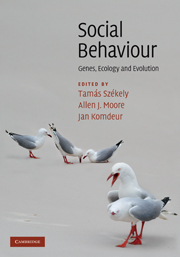Book contents
- Frontmatter
- Contents
- List of contributors
- Introduction: The uphill climb of sociobiology: towards a new synthesis
- Profile: Undiminished passion
- Part I Foundations
- Part II Themes
- 7 Aggression: towards an integration of gene, brain and behaviour
- Profile: From behavioural observations, to genes, to evolution
- 8 Social influences on communication signals: from honesty to exploitation
- Profile: Reputation can make the world go round – or why we are sometimes social
- 9 Important topics in group living
- Profile: A haphazard career
- 10 Sexual behaviour: conflict, cooperation and coevolution
- Profile: In celebration of questions, past, present and future
- 11 Pair bonds and parental behaviour
- Profile: Mating systems and genetic variation
- 12 Adaptations and constraints in the evolution of delayed dispersal: implications for cooperation
- Profile: Selections from a life in social selection
- 13 Social behaviour in microorganisms
- Profile: The de novo evolution of cooperation: an unlikely event
- 14 Social environments, social tactics and their fitness consequences in complex mammalian societies
- Profile: Evolutionary genetics and social behaviour: changed perspectives on sexual coevolution
- 15 Social behaviour in humans
- Profile: Genes and social behaviour: from gene to genome to 1000 genomes
- Part III Implications
- Species index
- Subject index
- References
11 - Pair bonds and parental behaviour
Published online by Cambridge University Press: 05 June 2012
- Frontmatter
- Contents
- List of contributors
- Introduction: The uphill climb of sociobiology: towards a new synthesis
- Profile: Undiminished passion
- Part I Foundations
- Part II Themes
- 7 Aggression: towards an integration of gene, brain and behaviour
- Profile: From behavioural observations, to genes, to evolution
- 8 Social influences on communication signals: from honesty to exploitation
- Profile: Reputation can make the world go round – or why we are sometimes social
- 9 Important topics in group living
- Profile: A haphazard career
- 10 Sexual behaviour: conflict, cooperation and coevolution
- Profile: In celebration of questions, past, present and future
- 11 Pair bonds and parental behaviour
- Profile: Mating systems and genetic variation
- 12 Adaptations and constraints in the evolution of delayed dispersal: implications for cooperation
- Profile: Selections from a life in social selection
- 13 Social behaviour in microorganisms
- Profile: The de novo evolution of cooperation: an unlikely event
- 14 Social environments, social tactics and their fitness consequences in complex mammalian societies
- Profile: Evolutionary genetics and social behaviour: changed perspectives on sexual coevolution
- 15 Social behaviour in humans
- Profile: Genes and social behaviour: from gene to genome to 1000 genomes
- Part III Implications
- Species index
- Subject index
- References
Summary
Overview
Pair bonds and parental behaviour are among the most variable social traits. To understand how and why these traits are so variable, we investigate three issues in this chapter. First, we present an overview of recent work on molecular and neural aspects of pair bonds and parental care using microtine rodents as model organisms. We focus on two neuropeptides, oxytocin and vasopressin, and show that although both molecules are found in both sexes, oxytocin plays a more prominent role in regulating parenting and pair bonding in females, whereas vasopressin serves this role in males. Variation in the expression of oxytocin and vasopressin receptors appears to contribute to species and individual differences in social behaviour. These studies also show that although oxytocin and vasopressin function in distinct brain regions, they act within the same neural circuit. Therefore, females and males appear to accomplish behavioural changes in pair bonding and parental care by altering the responsiveness of the same neural circuit. Second, studies of pair bonds and parental care in natural populations have revealed that these traits are often tied together. Cost–benefit analyses of both traits in a game-theoretic framework provide novel insights into how diverse pair bonding and parental care may have evolved. Recent work emphasises the role of social environment in influencing pair bonding and care. Finally, we point out that currently there is a schism between proximate and ultimate approaches to understanding pair bonding and parental care.
- Type
- Chapter
- Information
- Social BehaviourGenes, Ecology and Evolution, pp. 271 - 301Publisher: Cambridge University PressPrint publication year: 2010
References
- 21
- Cited by



